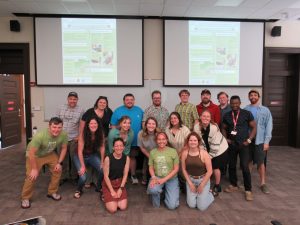As the spring semester ended, students invested in different areas of freshwater studies took the opportunity to show off their projects and presentation skills.
Drs. Carla Atkinson, Arial Shogren and other faculty members from The University of Alabama’s Center for Freshwater Studies hosted the Freshwater Alabama Biology Symposium on the final day of the semester. As the event began, students posed for fun photos in Smith Hall where murals and displays of mussels and other aquatic life adorn the walls of the upper floor. From there, they moved into a classroom to show off their knowledge but without having the pressure of a grade.
In preparation for the 2024 Society for Freshwater Science annual meeting in Philadelphia, the students were given the opportunity to present their research and methodology to their peers and faculty. This allowed them to hone their presentation skills, receive feedback and answer any questions about their topics. Some of the research subjects included testing for negative relationships between streamflow and freshwater mussel growth rates across streams, influence of flow intermittency on leaf litter decomposition and macroinvertebrate communities in a coastal plain stream network and light and temperature as drivers of organismal metabolism in Alaska.
About the UA Center for Freshwater Studies
The Center for Freshwater Studies was established to coalesce the interests of UA faculty with expertise in different areas of freshwater studies and to provide a focus and organized structure for interdisciplinary research and education. Currently, faculty from units within four colleges participate in the CFS and contribute expertise in biogeochemistry, biodiversity, conservation, ecology, geochemistry, geography, geology, hydrology, water policy/law and water resources management.
About the Society for Freshwater Science
The Society for Freshwater Science is an international scientific organization whose purpose is to promote further understanding of freshwater ecosystems, such as rivers, streams, lakes, reservoirs and estuaries, and ecosystems at the interface between aquatic and terrestrial habitats. The society fosters the exchange of scientific information among the membership, and with other professional societies, resource managers, policymakers, educators and the public.

